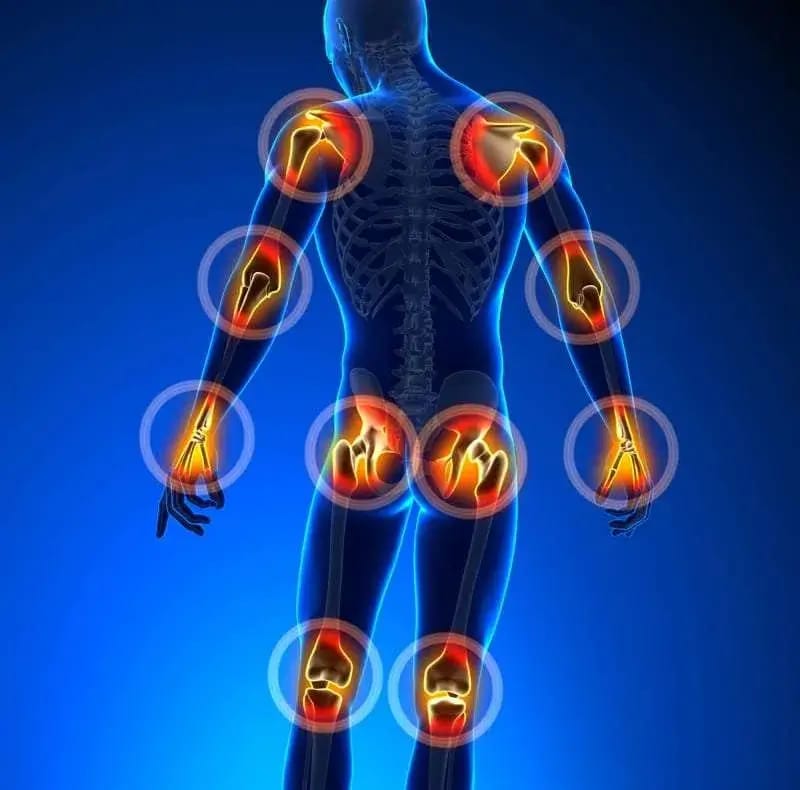
Unlocking - Relief from Chronic Pain
In pain management, patients present with a variety of conditions, each requiring careful assessment, diagnosis, and treatment. Here are some common conditions that patients may experience in pain management. We are explaining two major categories of pain in detail: Back pain and Neck pain.
Back Pain
1. Mechanical Back Pain
Cause:
Mechanical back pain, also known as non-specific back pain, is often caused by muscle strains, ligament sprains, or joint dysfunction due to poor posture, improper lifting techniques, overuse, or sudden movements.
Symptoms:
Dull ache in the lower back or upper back, stiffness, and limited range of motion, the pain may worsen with certain movements or activities.

2. Herniated Disc (Bulging or Ruptured Disc)
Cause:
A herniated disc occurs when the soft inner material of a spinal disc protrudes through the tough outer layer, often due to age-related degeneration, trauma, or repetitive stress on the spine.
Symptoms:
Sharp, shooting pain that radiates down one or both legs (sciatica), numbness, tingling, or weakness in the leg or foot, the pain may worsen with sitting, bending, or lifting.
3. Degenerative Disc Disease
Cause:
Degenerative changes in the spinal discs, such as loss of disc height, dehydration, and weakening of the outer layers, these commonly occur with aging, repetitive stress, or injury.
Symptoms:
Chronic low back pain, stiffness, decreased flexibility, and occasional flare-ups of acute pain, the pain may worsen with prolonged sitting or standing.
4. Spinal Stenosis
Cause:
Spinal stenosis is the narrowing of the spinal canal or neural foramina, often due to age-related changes, herniated discs, bone spurs, or thickened ligaments.
Symptoms:
Pain, numbness, tingling, or weakness in the legs with walking or standing (neurogenic claudication) & relieved by sitting or bending forward, the pain may worsen with extension of the spine.
5. Spondylolisthesis
Cause:
Spondylolisthesis is the forward slippage of one vertebra over another, commonly caused by stress fractures (spondylolysis), degenerative changes, or congenital defects.
Symptoms:
There is lower back pain, stiffness, muscle tightness & also potential nerve compression symptoms if the displaced vertebra impinges on nearby nerves.
6. Facet Joint Dysfunction:
Cause:
Degeneration, inflammation, or injury to the facet joints (small joints in the spine) can cause pain and stiffness in the back.
Symptoms:
Localized pain in the affected area, aggravated by extension or rotation of the spine, the pain may radiate to the buttocks or thighs.
7. Muscle Spasm
Cause:
Sudden, involuntary contraction of the muscles in the back arises due to overexertion, poor posture, stress, or injury.
Symptoms:
Intense, cramping pain arises in the affected muscle(s) along with restricted movement and tenderness to touch.
8. Compression Fracture
Cause:
Compression fractures occur when the vertebrae collapse or fracture, often due to osteoporosis, trauma, or cancer.
Symptoms:
There is sudden onset of severe back pain, worsened with movement or weight-bearing; height loss and kyphosis (forward curvature of the spine) occur.
Neck Pain
1. Muscle Strain or Sprain
Cause:
Overuse, poor posture, sudden movements, or muscle fatigue can lead to strain or sprain of the muscles and ligaments in the neck.
Symptoms:
There is dull, aching pain in the neck and shoulders, stiffness, and limited range of motion.

2. Cervical Spondylosis (Degenerative Disc Disease)
Cause:
Age-related changes, disc dehydration, loss of disc height, and wear and tear over time can lead to degenerative changes in the cervical spine.
Symptoms:
Chronic neck pain, stiffness & decreased flexibility arise with occasional flare-ups of acute pain.
3. Cervical Herniated Disc
Cause:
Degeneration, injury, or wear & tear of the intervertebral discs can cause the inner gel-like material to protrude or rupture through the tough outer layer of the disc, irritating nearby nerves.
Symptoms:
Pain radiates down the arm or into the shoulder or shoulder blade; there is numbness, tingling, or weakness in the arm or hand.
4. Cervical Stenosis
Cause:
Narrowing of the spinal canal in the cervical spine due to degenerative changes, bone spurs, herniated discs, or thickened ligaments can compress the spinal cord and nerves.
Symptoms:
There is neck pain, numbness, weakness, or clumsiness in the hands and potential difficulty with balance or coordination if spinal cord compression is severe.
5. Facet Joint Dysfunction
Cause:
Degeneration, inflammation, or injury to the facet joints (small joints in the spine that provide stability and enable movement) can cause pain and stiffness in the neck.
Symptoms:
Localized pain in the neck, aggravated by extension or rotation of the neck, the pain may radiate to the shoulders or upper back.
6. Cervical Radiculopathy (Pinched Nerve)
Cause:
There is compression or irritation of a spinal nerve root in the cervical spine, often due to herniated discs, bone spurs, or degenerative changes.
Symptoms:
There is pain, numbness, tingling, or weakness that radiates into the shoulder, arm, or hand, along the path of the affected nerve.
7. Cervical Muscle Spasm
Cause:
Sudden, involuntary contraction of the muscles in the neck arises due to overexertion, poor posture, stress, or injury.
Symptoms:
Intense, cramping pain in the neck and upper shoulders, there is restricted movement and tenderness to touch.
8. Whiplash Injury
Cause:
Rapid acceleration-deceleration forces on the neck, often due to motor vehicle accidents, falls, or sports injuries, can cause soft tissue damage, muscle strain, and ligament sprain.
Symptoms:
Neck pain and stiffness, headache, dizziness, blurred vision, difficulty in concentration arise & potentially symptoms of concussion if associated with head trauma.
Joint Pain
Joint pain can arise from various causes, each affecting the joints differently. Understanding the underlying causes and symptoms associated with joint pain can aid in proper diagnosis and treatment. Here are some common causes of joint pain and their associated symptoms:
1. Osteoarthritis (OA)
Cause:
Osteoarthritis is a degenerative joint disease characterized by the breakdown of cartilage, the cushioning tissue between bones in joints.
Symptoms:
Joint pain, stiffness, swelling, decreased range of motion, and crepitus (grinding sensation) in the affected joint(s). Symptoms often worsen with activity and improve with rest.

2. Rheumatoid Arthritis (RA)
Cause:
Rheumatoid arthritis is an autoimmune disorder in which the body's immune system mistakenly attacks the synovium (lining of the membranes surrounding joints), leading to inflammation and joint damage.
Symptoms:
Joint pain, swelling, stiffness, warmth, and redness in multiple joints, particularly small joints of the hands and feet. Morning stiffness lasting more than an hour is common.
3. Gout
Cause:
Gout is a form of arthritis caused by the accumulation of urate crystals in the joints, leading to inflammation and pain.
Symptoms:
Sudden and severe joint pain, swelling, redness, and warmth, typically affecting the big toe but can also occur in other joints such as the ankles, knees, or wrists.
4. Injury or Trauma
Cause:
Joint pain can result from acute injuries such as sprains, strains, fractures, or dislocations, or chronic overuse injuries.
Symptoms:
Localized pain, tenderness, swelling, bruising, instability, and decreased range of motion in the affected joint(s). Symptoms may vary depending on the severity and type of injury.
5. Infection
Cause:
Bacterial, viral, or fungal infections can lead to joint inflammation and pain, known as infectious arthritis or septic arthritis.
Symptoms:
Acute onset of joint pain, swelling, warmth, redness, fever, chills, and fatigue. Symptoms may progress rapidly and require urgent medical attention.
6. Autoimmune Disorders
Cause:
Various autoimmune diseases, such as lupus, psoriatic arthritis, or ankylosing spondylitis, can cause joint inflammation and pain due to the body's immune system attacking its tissues.
Symptoms:
Joint pain, stiffness, swelling, and fatigue, often accompanied by other systemic symptoms such as skin rashes, fever, or organ involvement.
7. Other Causes
Cause:
Joint pain can also be caused by conditions such as fibromyalgia, bursitis, tendonitis, Lyme disease, osteoporosis, or metabolic disorders.
Symptoms:
Symptoms can vary widely depending on the specific condition, but may include chronic pain, stiffness, and swelling, among others.
Migraine
Migraine is a neurological disorder characterized by recurrent episodes of severe, throbbing headaches often accompanied by other symptoms such as nausea, vomiting, and sensitivity to light, sound, or smells. It affects millions of people worldwide and can significantly impair daily functioning and quality of life. Here's a detailed overview of migraine:
1. Symptoms
Headache:
Migraine headaches typically involve severe, pulsating pain on one side of the head, although they can occur on both sides. The pain is often described as throbbing or pulsating and can last for hours to days

Aura:
Some individuals with migraine experience visual, sensory, or motor disturbances known as aura before or during the headache phase. Auras may include visual changes like flashing lights or blind spots, sensory changes such as tingling or numbness, or motor symptoms like weakness or difficulty speaking.
Nausea and vomiting:
Many migraine sufferers experience gastrointestinal symptoms such as nausea and vomiting during a migraine attack.
Sensitivity to stimuli:
Migraine attacks often lead to increased sensitivity to light (photophobia), sound (phonophobia), and smells (osmophobia). These sensitivities can exacerbate symptoms and make the headache more debilitating.
Fatigue and mood changes:
Migraine attacks may leave individuals feeling fatigued and mentally drained. Mood changes such as irritability, depression, or anxiety are also common during and after a migraine episode.
2. Types of Migraine:
Migraine without aura:
This is the most common type of migraine, characterized by recurrent headache attacks without preceding aura symptoms.
Migraine with aura:
Some individuals experience sensory disturbances or other neurological symptoms, known as aura, before or during a migraine attack. Aura symptoms typically precede the headache phase but can occur concurrently.
Chronic migraine:
Chronic migraine is defined as experiencing migraine headaches on 15 or more days per month, with at least eight of those days meeting the criteria for migraine.
3. Causes and Triggers
Genetics:
Migraine has a strong genetic component, with a family history of migraine increasing the risk of developing the condition.
Neurological factors:
Migraine is believed to involve abnormalities in the brain's sensory processing, including changes in neurotransmitter levels, cortical spreading depression, and abnormal activation of pain pathways.
Triggers:
Various factors can trigger migraine attacks in susceptible individuals, including certain foods (e.g., aged cheeses, chocolate), hormonal changes (e.g., menstrual cycle fluctuations), stress, sleep disturbances, environmental factors (e.g., weather changes, strong odors), and certain medications.